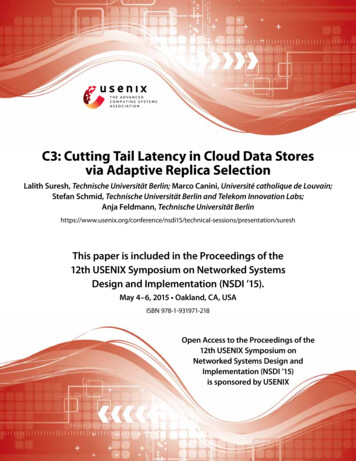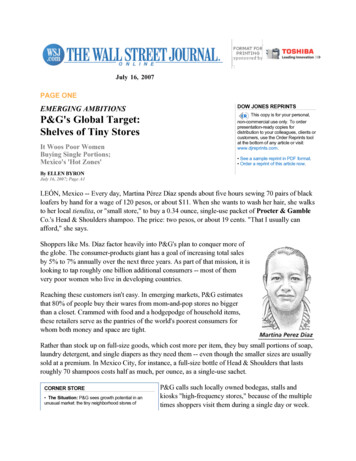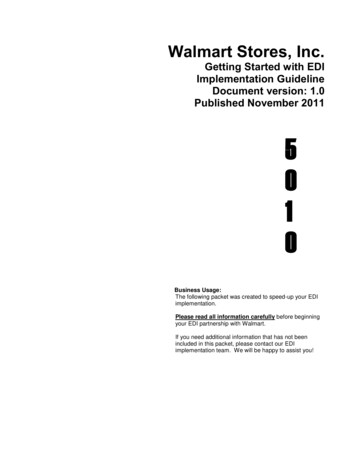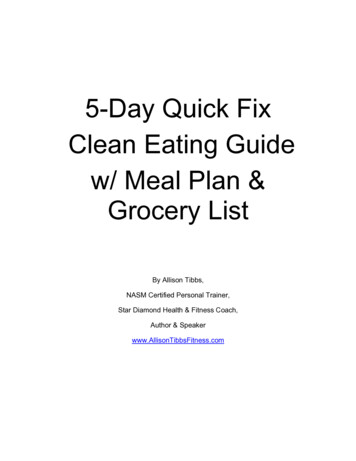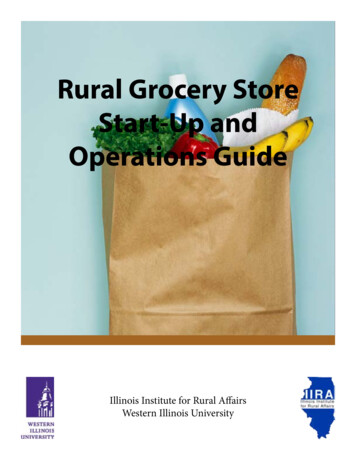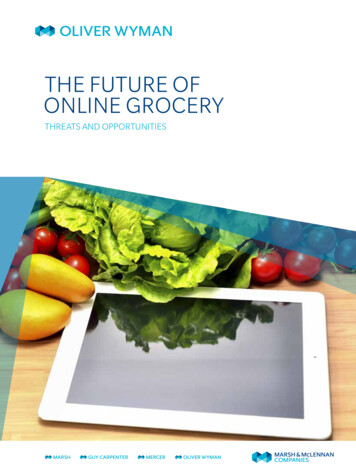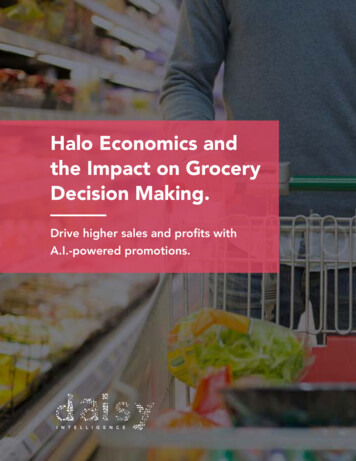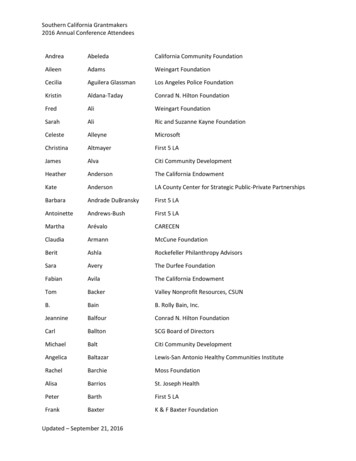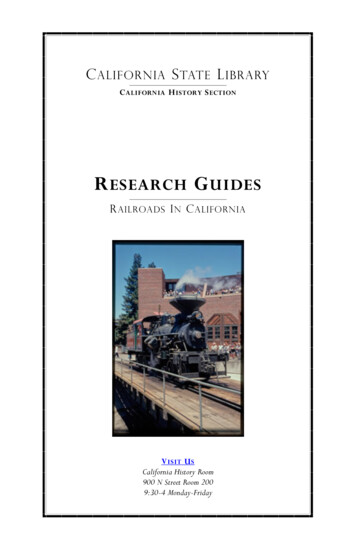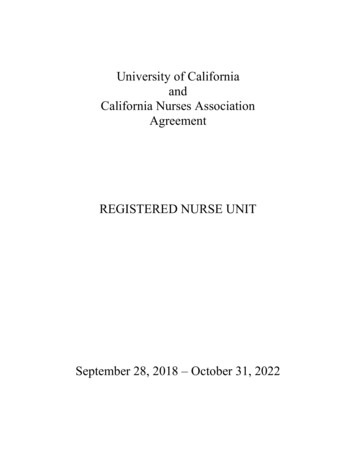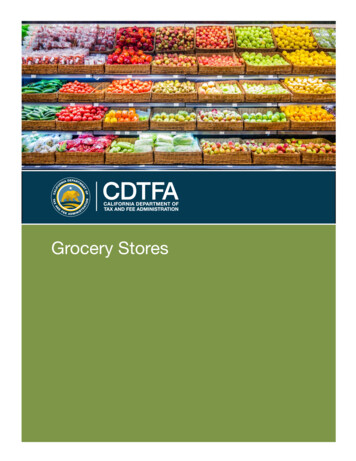
Transcription
Grocery Stores
PrefaceThis publication is designed for owners, managers, and other operators of grocery stores and provides basicinformation on the application of the California Sales and Use Tax Law to grocery store sales and purchases.For purposes of this publication, a grocery store is an establishment having as its principal line of business the saleof food products and related items. The term includes separate grocery departments in department stores but doesnot include delicatessens, country or general stores, and establishments that handle groceries as a sideline.If you have questions that are not answered in this publication, please visit our Tax Guide for Grocery Stores atwww.cdtfa.ca.gov/industry/grocery.htm or call our Customer Service Center at 1-800-400-7115 (CRS:711). Customerservice representatives are available to assist you Monday through Friday from 8:00 a.m. to 5:00 p.m. (Pacifictime), except state holidays. This publication complements publication 73, Your California Seller’s Permit, whichincludes general information about obtaining a permit; using a resale certificate; collecting and reporting salesand use taxes; buying, selling, or discontinuing a business; and keeping records. Please also refer to the For MoreInformation section for California Department of Tax and Fee Administration (CDTFA) information and the completelist of regulations, guides, and publications referenced in this publication.We welcome your suggestions for improving this or any other publication. If you would like to comment, pleaseprovide your comments or suggestions directly to:Audit and Information Section MIC:44California Department of Tax and Fee AdministrationPO Box 942879Sacramento, CA 94279-0044Please note: This publication summarizes the law and applicable regulations in effect when the publication waswritten, as noted on the cover. However, changes in the law or in regulations may have occurred since that time. Ifthere is a conflict between the text in this publication and the law, the law is controlling.
ContentsChapterGeneral Application of TaxPage1Taxable sales1Nontaxable sales1Food product sales2Vitamin enhanced water2Combination packages2Nonedible cake decorations4Food or dietary supplements or adjuncts (additives)4Dietary supplements provided by physicians5Herbal products5Hot prepared food products5To-go sales of meal packages that do not include hot items5Food service operations6Miscellaneous charges and transactionsCalifornia Redemption Value (recycling fee)Diapers and Menstrual Hygiene ProductsDiscounts, coupons, rebates, and incentive programsWhen is the rebate or incentive payment taxable?Promotional programs offered by third partiesDiscount club cardsFederal food stampsFilm processingLotteryNewspapers and periodicalsPoint-of-sale fees (fees for use of debit cards)Prepaid telephone debit cards and prepaid wireless cardsSales of capital assetsSelf-consumed merchandiseVending machines667788991010101010111111
Reporting Tax: Special Considerations for Grocery Stores12Total sales12Methods for computing exempt food sales and taxable sales12Electronic scanning systemsRecordkeeping requirements for grocers usingelectronic scanning systemsPurchase-ratio method (grocer’s formula)Modified purchase-ratio methodCost-plus-markup method—taxable merchandiseRetail inventory methodOther methodsSales tax ring-upTaxable sale ring-upEstimatesDeductionsLossesShrinkage (unaccounted-for-losses)Robbery, theft, shopliftingBad debtsHow long should I keep my business records?12131416172020202121212121212122For More Information23Appendix: Classification of Products Sold by Grocers25
General Application of TaxIt is important to understand how tax applies to your sales of food, merchandise, and other physical products. Thischapter is designed to answer questions commonly asked by grocers. Please visit our online Tax Guide for Grocery Storesat www.cdtfa.ca.gov/industry/grocery.htm or the For More Information section for CDTFA information and thecomplete list of regulations and publications referenced in this publication.Examples of taxable and nontaxable salesThe following examples do not represent all taxable and nontaxable sales.Taxable salesSales tax generally applies to sales of: Alcoholic beverages Books and publications Cameras and film Carbonated and effervescent water Carbonated soft drinks and mixes Clothing Cosmetics Dietary supplements Drug sundries, toys, hardware, and household goods Fixtures and equipment used in an activity requiring the holding of a seller’s permit, if sold at retail Food sold for consumption on your premises (see Food service operations) Hot prepared food products (see Hot prepared food products) Ice Kombucha tea (if alcohol content is 0.5 percent or greater by volume) Medicated gum (Nicorette, Aspergum) Newspapers and periodicals Nursery stock Over-the-counter medicines, such as aspirin, cough syrups, cough drops, throat lozenges, etc. Pet food and supplies Soaps or detergents Sporting goods Tobacco productsNontaxable salesSales tax generally does not apply to sales of: Baby formulas (including Isomil) Cooking wine Edge Bars, Energy Bars, Power Bars Food products—This includes baby food, artificial sweeteners, candy, gum, ice cream, ice cream novelties,popsicles, fruit and vegetable juices, olives, onions, and maraschino cherries. Food products also includebeverages and cocktail mixes that are neither alcoholic nor carbonated. The exemption applies whether sold inliquid or frozen form.OCTOBER 2020 GROCERY STORES1
Granola Bars Kombucha tea (if less than 0.5 percent alcohol by volume and naturally effervescent) Martinelli’s Sparkling Cider Noncarbonated sports drinks (Gatorade, Powerade, All-Sport) Pedialyte Phone cards (see Prepaid telephone debit cards and prepaid wireless cards) Water—Bottled noncarbonated, noneffervescent drinking waterFood product salesAlthough sales of food products for human consumption (food that people eat) are generally exempt from tax,there are many sales of food products that are taxable. For example, you must report tax on sales of food productssold for consumption on your premises when eating facilities are provided. Because certain sales of food productsare taxable, it is important to understand when tax applies.If an item does not qualify as a food product, or if it is not sold for human consumption, it is generally subject to tax.For example, the following items do not qualify as food products and, as a result, are subject to tax: Alcoholic beverages Carbonated beverages, including semi-frozen beveragescontaining carbonation, such as slushies (also see “Pleasenote” below) Coloring extracts Dietary supplements Ice Over-the-counter medicines Tobacco productsLikewise, a food product sold for consumption by a dog, cat, bird, and other domestic pets, or for use as fish bait, istaxable because it is not sold as a food for people to eat.Please note: Carbonated fruit juices. Carbonated products that qualify as 100 percent natural fruit juice are notsubject to tax. If the fruit juice includes a preservative, such as sodium benzoate, or any other additive, it is notconsidered a natural fruit juice and is taxable.Vitamin enhanced waterNoncarbonated, vitamin enhanced water beverages and sport drinks that come in packages similar in size andvolume to nonenhanced bottled water are generally considered food products. Your sales of these products on ato-go basis are generally not subject to tax. Noncarbonated bottled water is specifically considered a food item.The specially mixing or compounding of nutritional elements, such as vitamins, in an item traditionally acceptedas food, such as vitamin enriched bread, does not alone render the product taxable nor does including the word“vitamin” in a food product name, description, or product advertising. For more information, please see Regulation1602, Food Products.Combination packagesCombination packages may include food or a combination of food and nonfood items. If you create gift packages(basket) that contain only food, such as cheese, crackers, or fruit, the sale of these gift packages is generally exemptfrom tax. If you decide to include a nonfood product in a gift basket, it is necessary to determine the taxable portionof the combination package. A container is generally considered the package and any packaging material thatholds the product being sold.2GROCERY STORES OCTOBER 2020
If you maintain records that verify the cost of the individual itemsYou must continue to separate the retail value of the nonfood products when:1. You have records that verify the cost of the individual items in the package and2. The retail price of the nonfood product is more than ten percent of the retail value of the entire package, notincluding the container.The tax is based on the retail sales price of the nonfood products not including the value of the container. Forexample, you have records to establish the cost of the individual items of a combination package, and your saleincludes the following components:Meat and cheese, retail value (exempt food products)Serving utensil, retail value (nonfood product)Total retail value of contentsTray (container) retail valueTotalSales tax ( 5 * x 8.25%)Total selling price of combination package 22.005.00* 27.003.0030.00.41 30.41*Total retail value of the nonfood productsIn this example, the retail value of the nonfood item, 5.00, is greater than 10 percent of the retail value of theentire package, not including the container (tray) ( 27 x 10% 2.70). Additionally, the retail value of the containeris less than 50 percent of the retail value of the entire package. Since you have records to establish the cost of theindividual items of the combination package, the tax is measured by the retail sales price of the nonfood productsnot including the value of the tray ( 5.00 x appropriate tax rate).If you do not have records to verify the cost of the individual itemsTax may be measured by the retail sales price of the entire package, including the value of the container if:1. The retail value of the nonfood product exceeds ten percent of the retail price of the entire package, notincluding the container, and2. You do not have records to establish the cost of the individual items of the combination package.This would also apply if you were selling prepackaged gift baskets, since you do not have records for the cost of theindividual items in the package. For example, if you do not have records to establish the cost of the individual itemsof a combination package and your sale includes the following components:Meat and cheese, retail value (exempt food products)Serving utensil, retail value (nonfood product)Total retail value of contentsTray (container) retail valueTotalSales tax ( 30 x 8.25%)Total selling price of combination package 22.005.00 27.003.00 30.002.48 32.48In this example, the retail value of the nonfood item, 5.00, is greater than ten percent of the retail value of theentire package, not including the container ( 27 x 10% 2.70). However, since you do not have records toestablish the cost of the individual items of the combination package, the tax is measured by the retail sales price ofthe entire package, including the value of the tray ( 30.00 x appropriate tax rate).OCTOBER 2020 GROCERY STORES3
If you do or do not have records to verify the cost of the individual itemsThe sales price of the package is nontaxable if:1. The retail value of the nonfood products is ten percent or less than the total value of the contents (notincluding the container), and2. The container’s retail value is 50 percent or less of the entire package value.For example, your sale includes the following components:Cheeses, retail value (exempt food products)Small knife, retail value (nonfood product)Total retail value of contentsContainer, retail valueTotal selling price of combination package 45.005.00 50.0010.00 60.00The nontaxable combination package meets both conditions explained in the example above. The value of the nonfooditems, 5.00, is 10 percent of the 50 total value of the contents ( 50 x 10% 5). The value of the container, 10.00, is lessthan 50 percent of the retail value of the entire package ( 60 x 50% 30). Your sale qualifies as a nontaxable sale.Please note: In these examples, we show tax calculated at a rate of 8.25 percent, however, you should use the taxrate in effect at your business location. For current tax rates, see California City and County Sales and Use Tax Rates,available on our website or by calling our Customer Service Center. If you would like more information, please alsosee Regulation 1602, Food Products.Nonedible cake decorationsIf you sell a cake or other bakery goods that includes nonedible decorations, you must report tax on the retailselling price of the decorations if they represent 50 percent or more of the total retail value of the cake or bakeryitem. You must segregate the charge for the decorations from the charge for the cake or bakery item, and you mustcalculate the tax based on the retail value of the decorations.Please note: You may already separately state the retail value of decorations on the invoice. If you do, and thedecorations are nonedible, you must report tax based on the retail value of the decorations—whether or not theyrepresent at least 50 percent of the total retail value of the cake or bakery item.Food or dietary supplements or adjuncts (additives)Sales tax generally applies to preparations in liquid, powdered, granular,tablet, capsule, lozenge and pill form sold as food supplements, dietarysupplements, food additives or dietary additives. Supplements oradditives are not included in the definition of exempt food products. If anitem is sold in one of these specified forms, the following methods may beused to determine its taxability: If an item is described on its label or package as a food supplement,food adjunct, dietary supplement, or dietary additive, its sale would besubject to the sales tax. If an item is prescribed or designed to remedy specific dietarydeficiencies or to increase or decrease generally those areas of humannutrition dealing with vitamins, proteins, minerals or calories, its sale would be subject to the sales tax. If an item is in one of the specified forms, it may be taxable if it is generally recognized as a dietary supplement,even though it is not described as such on its package and does not emphasize its vitamin, protein, mineral orcalorie content. Examples include cod liver oil, wheat germ oil, and halibut liver oil.4GROCERY STORES OCTOBER 2020
Revisions to Regulation 1602, Food Products, and Regulation 1591, Medicines and Medical Devices, clarify that dietarysupplements can, in limited circumstances, be considered “medicines.” This applies when supplements (provided bya physician to his or her own patient) are part of a medically supervised weight loss program to treat obesity.Dietary supplements provided by physiciansGenerally, if a supplement does not qualify as a complete dietary food under Regulation 1602, Food Products, it istaxable. However, the sale will not be taxable if a physician prescribes such a supplement to his or her own patientas part of a medically supervised weight loss program to treat obesity.Herbal productsA product’s labeling does not determine that it is a medicine and disqualify it from the food products exemption. Ifa product does not meet the definition of medicine, as provided in Regulation 1591, Medicines and Medical Devices, itmay still be considered a food product for human consumption. This is true even if medicinal claims are made on theproduct’s label or product brochures.If an herb is sold in cut leaf form, the herb cannot be considered a supplement or additive, regardless of what iswritten on the label because it is not in one of the forms listed in Regulation 1602, Food Products. Only a dried herbthat is ground or crushed into fine particles should be considered a powder. For such an herb to be considered tobe sold as a supplement or additive, it must be either: Labeled as a supplement or adjunct, or Prescribed or designed to meet specific dietary deficiencies or increase or decrease vitamins, proteins, minerals,and/or caloric intake.If the herb is not described on its package or label as a food supplement, food additive, dietary supplement, ordietary additive, the herb is a food product the sale of which is exempt from tax.Hot prepared food productsSales of hot prepared food products are subject to sales tax regardless of whether sold for consumption on thepremises or sold to go.A food product is considered a hot prepared food product if it is heated to a temperature above room temperature.Hot food is considered a hot prepared food product even if it has cooled by the time of sale since it was intended tobe sold as a hot food.Examples of hot prepared food products include hot pizza, hot barbecued chicken, hot spareribs, hot popcorn, andhot nuts (if you sell nuts from an enclosed display case which is heated through the use of an ordinary light globe,the sales are sales of hot food products and are subject to sales tax). Hot bouillon, consommé, and soup are alsoconsidered hot prepared food products and their sale is subject to tax. However, tax does not apply to the sale ofhot bakery items, hot coffee, and other hot beverages if they are sold individually and to go.Hot prepared food products also include a combination of hot and cold food items where a single price has beenestablished for the combination. Examples include a combination of coleslaw, rolls, and hot chicken sold for a singleprice; and a doughnut and coffee sold for a single price.To-go sales of meal packages that do not include hot itemsIf you sell a combination meal to go that includes cold food and a carbonated beverage, the portion of the sellingprice that represents the carbonated beverage is subject to tax. If the combo package includes cold food and abeverage other than a carbonated beverage, the sale of the package is not taxable.Example: You sell a combination of a cold sandwich, chips, and iced tea for a single price to go—the sale is nottaxable. You sell the same package with a carbonated soda—the portion of the selling price representing thecharge for the soda is taxable.OCTOBER 2020 GROCERY STORES5
Food service operationsFood sold for consumption at tables, chairs, or other facilities, that you provideIf your store has a snack bar, soda fountain, cafeteria or a similar operation, you must report sales tax for salesof sandwiches, ice cream, and other foods if those foods are sold in a form for consumption at tables, chairs, orcounters or from trays, glasses, dishes or other tableware that you provide. For example, if you provide either astand-up or sit-down counter in the delicatessen section, tax applies to food sold for consumption at the counter.To-go salesIn general, sales of cold food to go are not subject to tax. If you claim an exemption from tax for cold food sold togo, you must show that no facilities are provided where the food can be consumed immediately. If facilities areprovided, you must segregate your receipts of the nontaxable sales from the taxable “for here” sales. Your receiptscould include tapes from a separate cash register key, copies of sales slips, or some similar record that can beverified by audit. You can elect to charge tax on to go sales of cold food if more than 80 percent of your store’s sales are from thesale of food products and more than 80 percent of your store’s sales are taxable dine-in or hot food sales.CateringYou are considered a caterer for tax purposes if you serve meals, food, and drinks on the premises of your customers.If you make sales as a caterer, please see publication 22, Dining and Beverage Industry. Please also refer to theFor More Information section.Please note: If
Purchase-ratio method (grocer’s formula) 14 Modified purchase-ratio method 16 Cost-plus-markup method—taxable merchandise 17 Retail inventory method 20 Other methods 20 Sales tax ring-up 20 Taxable sale ring-up 21 Estimates 21 Deductions 21 Losses 21 Shrinkage (unaccounted-f
